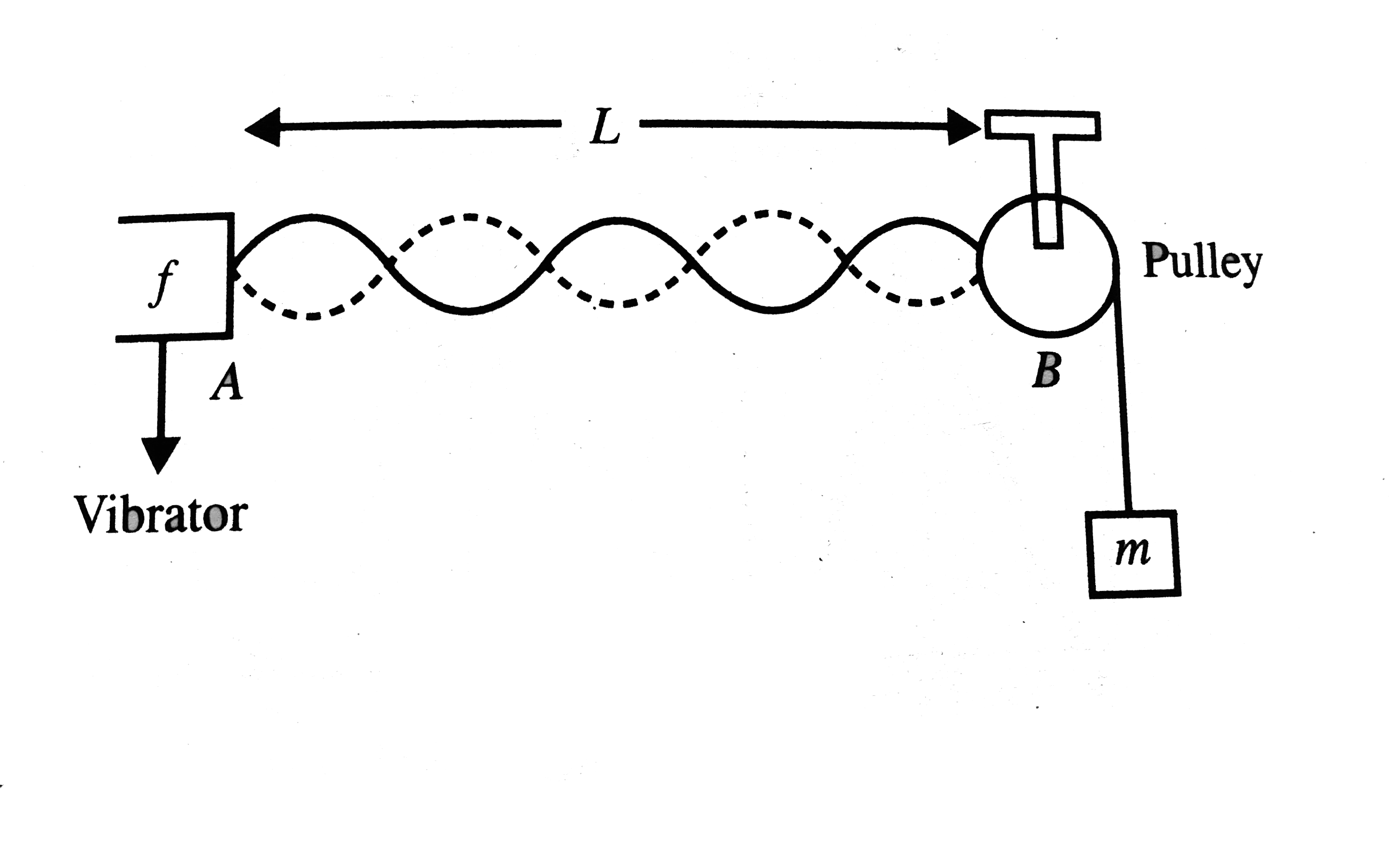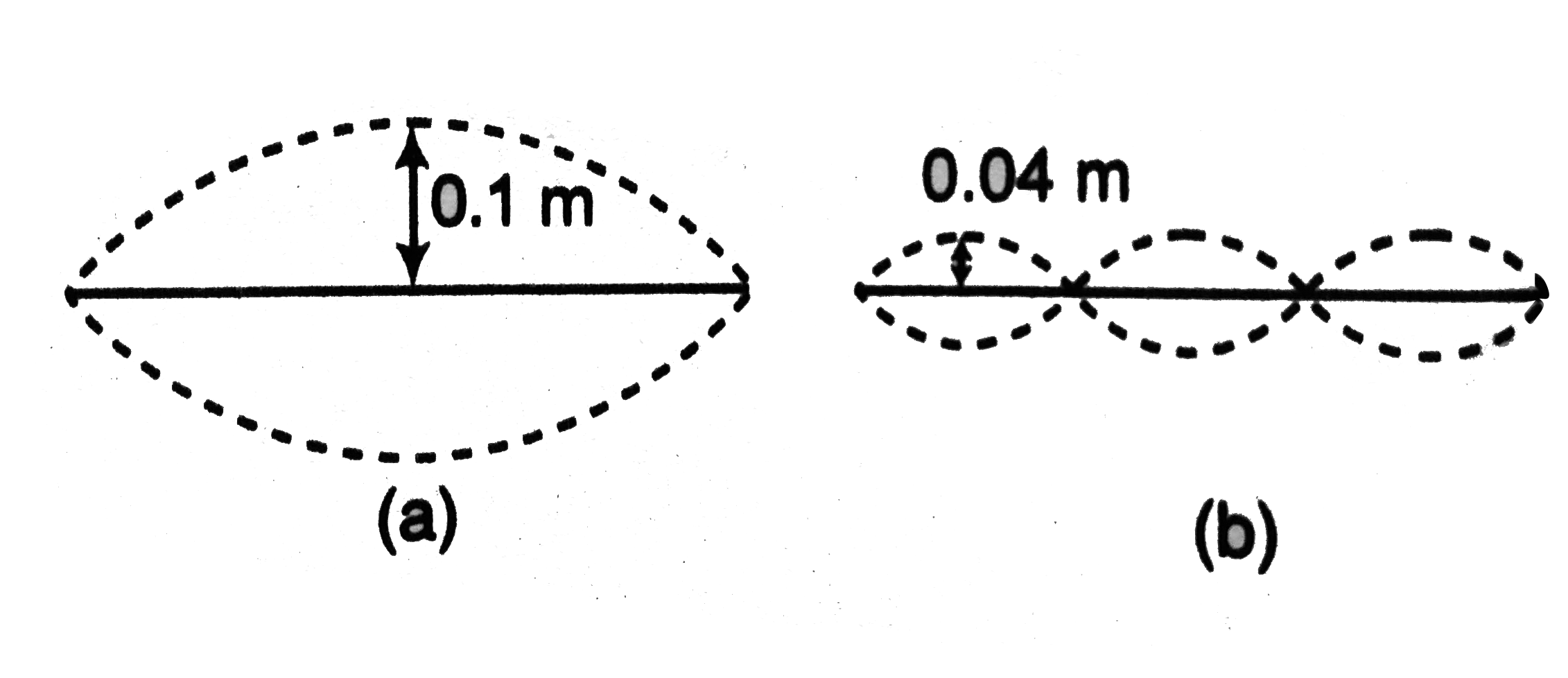A 2.0m long string with a linear mass density of 5.2×10−3kgm−1 and tension 52N has both of its ends fixed. It vibrates in a standing wave patten with four antinodes. Frequency of the vibraion is :-
75 Hz
150 Hz
100 Hz
50 Hz
The correct Answer is:C
To find the frequency of the vibration of the string, we can follow these steps:
Step 1: Understand the Problem
We have a string of length L=2.0m with both ends fixed. It has a linear mass density μ=5.2×10−3kg/m and is under a tension T=52N. The string vibrates in a standing wave pattern with four antinodes.
Step 2: Determine the Wavelength
In a standing wave with both ends fixed, the number of antinodes n is related to the wavelength λ by the formula:
n=Lλ/2
Given that there are four antinodes, we can write:
4=Lλ/2
This implies:
L=2×λ⇒λ=L2
Substituting L=2.0m:
λ=2.0m2=1.0m
Step 3: Calculate the Wave Velocity
The velocity v of a wave on a string is given by:
v=√Tμ
Substituting the values for tension T=52N and linear mass density μ=5.2×10−3kg/m:
v=√525.2×10−3
Calculating the denominator:
5.2×10−3=0.0052kg/m
Now, calculating v:
v=√520.0052=√10000=100m/s
Step 4: Calculate the Frequency
The frequency f of the wave can be calculated using the relationship:
f=vλ
Substituting the values for v and λ:
f=100m/s1.0m=100Hz
Final Answer
Thus, the frequency of the vibration is:
100Hz
---
We have a string of length L=2.0m with both ends fixed. It has a linear mass density μ=5.2×10−3kg/m and is under a tension T=52N. The string vibrates in a standing wave pattern with four antinodes.
In a standing wave with both ends fixed, the number of antinodes n is related to the wavelength λ by the formula:
n=Lλ/2
Given that there are four antinodes, we can write:
4=Lλ/2
This implies:
L=2×λ⇒λ=L2
Substituting L=2.0m:
λ=2.0m2=1.0m
The velocity v of a wave on a string is given by:
v=√Tμ
Substituting the values for tension T=52N and linear mass density μ=5.2×10−3kg/m:
v=√525.2×10−3
Calculating the denominator:
5.2×10−3=0.0052kg/m
Now, calculating v:
v=√520.0052=√10000=100m/s
The frequency f of the wave can be calculated using the relationship:
f=vλ
Substituting the values for v and λ:
f=100m/s1.0m=100Hz
Thus, the frequency of the vibration is:
100Hz
Topper's Solved these Questions
- RACEBOOK - ALLENCHAPTER - RACEEXERCISE - Basic Maths (Wave Motion & Dopplers Effect) (Superposition of waves interfarence, beats)
15 Videos
- NEWTONS LAWS OF MOTIONBOOK - ALLENCHAPTER - NEWTONS LAWS OF MOTIONEXERCISE - EXERCISE-III
28 Videos
- SIMPLE HARMONIC MOTIONBOOK - ALLENCHAPTER - SIMPLE HARMONIC MOTIONEXERCISE - Example
1 Videos
Similar Questions
A 100 Hz sinusoidal wave is travelling in the positve x - direaction along a string with a linear mass density of 3.5×10−3kgm−1 and a tension of 35 N. At time t =0 ,the point x=0 has zero displacment and the slope of the string is π/20then select the wrong alternative.
View SolutionIn the arrangement shown in Fig. 7.100 , mass can be hung from a string with a linear mass density of 2×10−3kg/m that passes over a light pulley . The string is connected to a vibrator of frequency 700Hz and the length of the string between the vibrator and the pulley is 1m.

If the mass suspended is 16kg , then the number of loops formed in the string is
View Solution
Knowledge Check
A one meter long string of mass 4.9×10−4 kg is held under a tension of 19.6 N. IF the string vibrates in one segment, then the frequency of vibration will be
A200 HzB100 HzC50 HzD400 Hz
In the arrangement shown in Fig. 7.100 , mass can be hung from a string with a linear mass density of 2×10−3kg/m that passes over a light pulley . The string is connected to a vibrator of frequency 700Hz and the length of the string between the vibrator and the pulley is 1m.

The string is set into vibrations and represented by the equation y=6sin(πx10)cmcos(14×103πt) where x ane y are in cm , and t in s, the maximum displacement at x=5m from the vibrator is
View SolutionFigure shows different standing wave patterns on a string of linear mass density 4.0×10−2kg/m under a tension of 100 N. The amplitude of antinodes is indicated in each figure. The length of the string is 2.0m.
(i) Obtain the frequencies of the modes shown in figures (a) and (b).
(ii)Write down the transverse displacement y as a function of x and t for each mode. (Take the initial configuration of the wire in each mode to be as shown by the dark lines in the figure).

View SolutionA sting of length 1m and linear mass density 0.01 kg/m is stretched to a tension of 100 N. When both ends of the string are fixed, the three lowest frequencies for standing wave are f1,f2andf3 . When only one end of the string is fixed, the three lowest frequencies for standing wave are n1,n2andn3. Then,
View SolutionTwo wires are together end to end . The wires are made of the same material , but the diameter of one is twice that of the other . They are subjected to a tension of 4.60N. The thin wire has a length of 40.0cm and a linear mass density of 2.00g/m. The combination is fixed at both ends and vibrated in such a way that two antinodes are present , with the node between them being precisely at the weld . (a) What is the frequency of vibration ? (b) Find the length of the thick wire .
View SolutionA 20cm long string, having a mass of 1.0g, is fixed at both the ends. The tension in the string is 0.5N. The string is into vibrations using an external vibrator of frequency 100Hz. Find the separation (in cm) between the successive nodes on the string.
View SolutionA stretched rope having linear mass density 5×10−2kg/m is under a tension of 80N. the power that has to be supoplied to the rope to generate harmonic waves at a frequency of 60Hz and an amplitude of 2√215πm is
View SolutionA steel wire 0.72 m long has a mass of 5.0×10−3 kg . If the wire is under a tension of 60 N, what is the speed of transverse waves on the wire ?
View Solution
